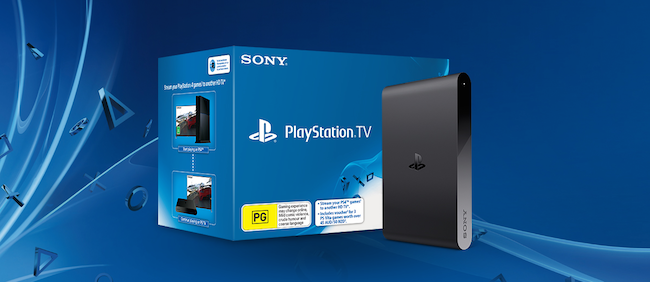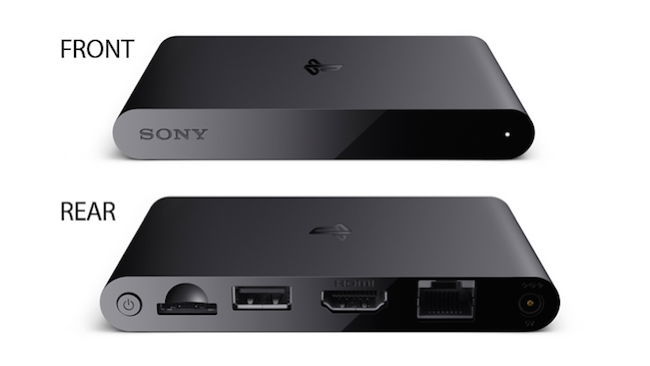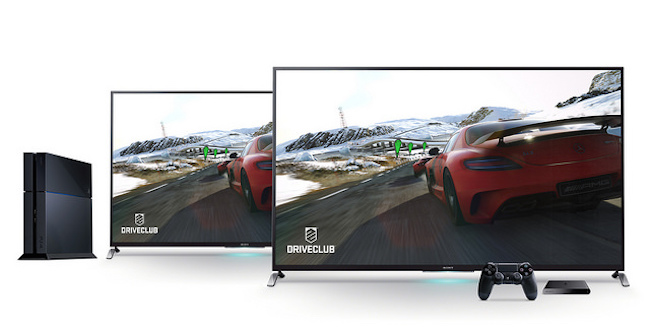
When I heard the announcement for PlayStation TV last year (also known as the PSVita TV in Japan), I was quickly sold on the concept. Being able to stream PS4 games to another TV, as well as playing VITA, PSP and PSone games on my TV sounded awesome. Not to mention a solid selection of apps, including the possibilities of the PlayStation Now service. For an approximate converted cost of one hundred dollars, the potential of this wallet-sized device was, in my opinion, leaps and bounds ahead of noted android-based competition, such as the Ouya and Amazon Fire TV.
Don’t get me wrong, the Amazon Fire TV is a fantastic device for services such as Netflix. However, for those of us in Australia without a working VPN or sub-par ADSL, all it really offers is a selection of Android games; any of which we could just as conveniently play on smartphones or other devices. The same goes for the Ouya, which offers similar outdated or uninteresting content, bundled with a terrible controller. The difference with PlayStation TV is that it was offering console-quality games that could be played with any existing PS3 or PS4 controller, and chances are that many Sony fans would likely have a few games in their digital library that would also be compatible too. A console is worthless without content, so for people who didn’t want the portable VITA, it was starting to look like a great option.

When I opened the box, I was initially surprised by just how small this sleek, black device is (about the size of a pack of playing cards). Also included in the box was the power adapter, power cable, HDMI cable, as well as a PSN voucher for 3 games: Worms: Revolution Extreme, Velocity Ultra and OlliOlli. From a physical perspective, it’s actually quite attractive and includes a robust set of inputs for something so small. To clarify, on the device there is a Vita memory card slot, Vita game cartridge slot, USB 2.0 port, HDMI port, ethernet port, and, of course, a power input.
In terms of internal specs, we’re basically looking at a repackaged PSVita: quad-core processor, 512 MB RAM, 128 MB VRAM, as well as Wi-Fi & Bluetooth. Notably, the new system does come with 1GB of internal memory, but this cannot be used in conjunction with those overpriced proprietary memory cards. It’s a bit unreasonable they didn’t swap to micro-SD, but I don’t think anyone would have expected different. The biggest disappointment for me, however, was the glaring lack of 1080p output. It’s really great that you can stream games, but even over high-speed ethernet, it will never look as good as good as the original source. Another notable feature is that the device launched in Australia with support for both Dualshock 3 & 4 controllers, which is convenient for any well established Sony Fan.

The biggest features advertised for the PlayStation TV is that it can stream your PS4 to another TV, as well as play “compatible” PSVita, PSP & PSone games. It’s a micro-console, and it’s designed to be an entry point for people who might not want a PSVita, or are looking for a TV-compatable device to stream movies, TV and music (much like Apple TV). There are also promises of PlayStation Now, a cloud-based service which allows players to stream games from older systems, such as the PS3 (backwards compatibility, pretty much). Sony also recently announced PlayStation Vue, a cloud-based TV service much like Netflix, which should launch on the PSTV in 2015, depending on your region.
Let’s skip forward to what it can actually do right now, and in Australia. Currently, it can mostly fulfil its two biggest promises. Streaming works moderately well, and it can play “compatible” games just fine. Compatible is the word though, and it’s important to understand before purchasing that this device cannot currently play all games yet. For the type of games I enjoy, they all worked perfectly, and let me tell you too, being able to play Persona 4: Golden and Valkyria Chronicles II on a TV felt pretty damn cool. In regards to both PS Now and PS Vue, it has not yet been confirmed if these will ever be available in Australia, which does arguably shrink its widespread appeal at this point in time (likely because our internet sucks). Basically, it’s just a machine of convenience for gamers at this point in time.

Something that irked me as soon as I turned it on, is that the PSVita OS has been unapologetically ported as is. Sure, there are a few loose ends tied to make it work with a controller, but it just looks wrong on a TV. It’s clunky, and it’s glaringly obvious that it’s meant to be a touch interface. The OS also runs at an upscaled resolution, so you will see plenty jaggies all throughout the interface. It’s not that it’s difficult to navigate exactly, but it’s still very lazy and makes it feel like a sub-standard hack job. If Sony were hoping to compete with the Apple TV, they flopped in the presentation.
Putting aside that particular gripe, in terms of functionality, the PlayStation TV is a very capable micro-console and performs well all round. I’ve not had any games crash, and I’ve also been able to stream PS4 games perfectly fine, both through my router and with direct Wi-Fi. The controllers are simple to sync with a USB cable, and it’s no hassle swapping them back and forth between systems if you only own one. I have to admit that I’m quite disappointed with the apps on offer, with just an average media player on offer, but research shows that the US has a better offering. The most important thing here is that the PS TV does exactly what’s advertised on the box, and there is little to fault there.

 Compact, sleek and very simple to setup
Compact, sleek and very simple to setup
 Does exactly what it says it does on the box
Does exactly what it says it does on the box
 Largest library of games on a micro-console
Largest library of games on a micro-console
 Great integration with pre-existing products
Great integration with pre-existing products
 A lot of potential for PS Now & Vue services
A lot of potential for PS Now & Vue services
 Lack of 1080p support is a major detractor
Lack of 1080p support is a major detractor
 “Compatible” games could disappoint some
“Compatible” games could disappoint some
 OS is an unapologetically clunky port
OS is an unapologetically clunky port
 Costs more in AU, but currently offers less
Costs more in AU, but currently offers less
The PlayStation TV is a compact, sleek device that does exactly what it says it does: stream your PS4 to another TV and play games. In fact, it’s arguably the best micro-console available right now, boasting the largest selection of great games by comparison to the competition; despite the fact many are still incompatible. Unfortunately, however, the lack of 1080p and a clunky ported OS make the product feel sub-standard, so it’s probably not the best platform for other media. In fairness, there is still promise in PlayStation Now and Vue, but being in Australia also means that we might never see it too. If you’re interested in streaming or want to play portable games on a TV, it’s a neat add-on, but it’s not going to change anything radically today. At the time of writing, it’s an enthusiast device, but that could change.











